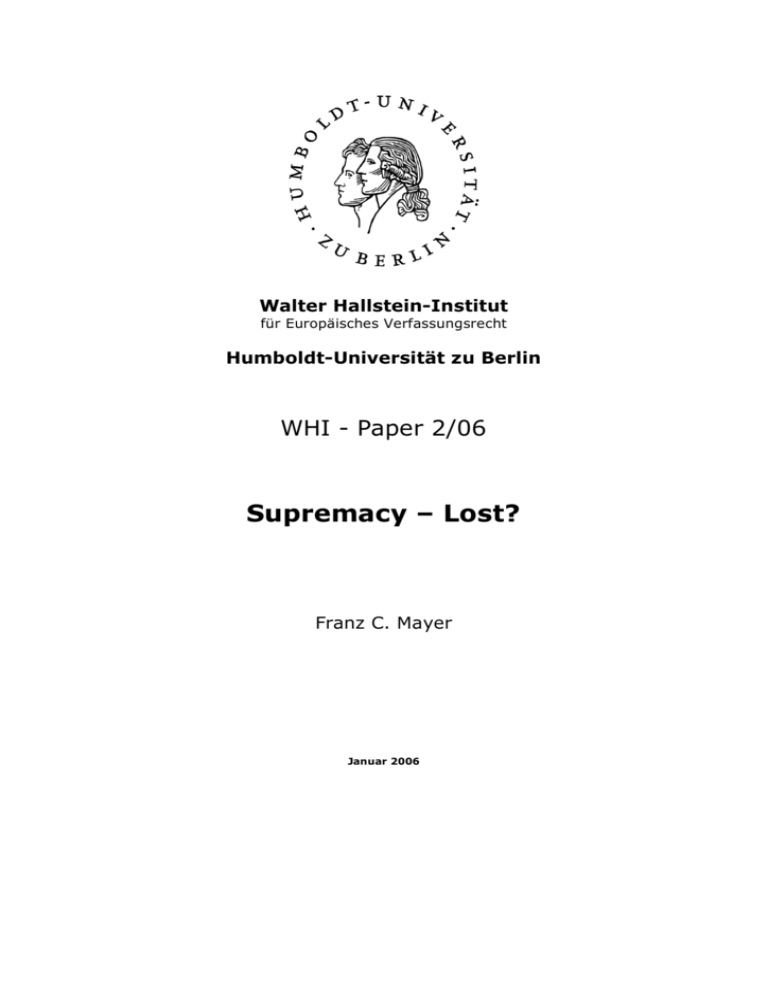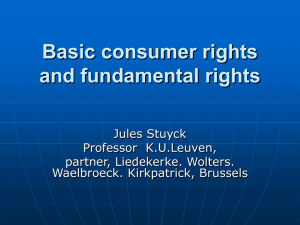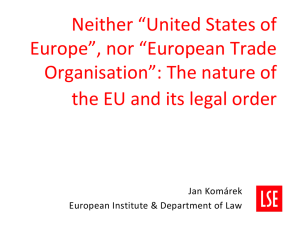Supremacy – Lost?
advertisement

Walter Hallstein-Institut für Europäisches Verfassungsrecht Humboldt-Universität zu Berlin WHI - Paper 2/06 Supremacy – Lost? Franz C. Mayer Januar 2006 Dieser Beitrag ist erstmals erschienen in Philipp Dann / Michal Rynkowski (eds.), The Unity of the European Constitution, Springer: Berlin, Heidelberg 2006, pp. 87 – 96 Siehe auch: German Law Journal Vol. 6 No. 11, pp. 1497 – 1506 Zitiervorschlag: http://www.whi-berlin.de/supremacy.htm Published in: Philipp Dann and Michal Rynkowski (eds.), The Unity of the European Constitution, Springer: Berlin, Heidelberg 2006, pp. 87 – 96 See also: German Law Journal Vol. 6 No. 11, pp. 1497 – 1506 _____________________________________________________ [*87] Supremacy - lost? Franz C. Mayer* A. Introduction The relationship between European Union law and national law is one of the most debated issues of European constitutional law. The Treaty establishing a Constitution for Europe (CT) introduces an article that, for the first time, explicitly states the primacy of European law over national law.1 A declaration annexed to the final act of the IGC states that this provision reflects existing Court of Justice case law. Thus, it is no surprise that most commentators agree that the Constitution does not change much concerning the relationship between European law and national law. However, the new provision does not only raise the question of what happened to supremacy (as opposed to primacy), it also offers the opportunity to recall the different aspects of the principle (B.) and to reflect on the role and the function not only of the principle, but also of legal scholarship in shaping the principle (C.). * Privatdozent, Dr. jur., LL.M. (Yale). Walter Hallstein-Institut, Juristische Fakultät, Humboldt Universität zu Berlin, fmayer@aya.yale.edu. 1 Art. I-5 CT: “The Constitution and law adopted by the institutions of the Union in exercising competences conferred on it shall have primacy over the law of the Member States.” 1 [*88] B. Some facts on primacy I. The cases A standard account on primacy has to start out from the 1963 Van Gend en Loos-decision of the European Court of Justice.2 In emphasizing that European law is to be distinguished from regular public international law and in according direct effect to European law, the ECJ made a direct conflict between European law and national law possible, without answering the question which law shall prevail. The 1964 Costa v. ENEL-decision3 answered this question, stating that in case of conflict between European law and national law, European law prevails. The ECJ’s core justifications for the primacy of European law are independence, uniformity and efficacy of Community law. In this perspective, Community law is “an integral part of [...] the legal order applicable in the territory of each of the Member States”, and provisions of Community law “by their entry into force render automatically inapplicable any conflicting provision of current national law”.4 This concept of primacy in application, Anwendungsvorrang (as opposed to primacy in validity, Geltungsvorrang), also applies to the Member States’ constitutional law provisions. The Court has been extremely reluctant, though, to state this openly. The decision in the case of Internationale Handelsgesellschaft decided in 1970 stands out as the case where the ECJ uses the strongest language with respect to primacy over the national constitution:5 “The validity of a Community measure or its effect within a Member State cannot be affected by allegations that it runs counter to either fundamental rights as formulated by the constitution of that state or the principles of a national constitutional structure.”6 2 Case 26/62, Van Gend en Loos, 1963 ECR 1 (English special edition) Case 6/64, Costa v. ENEL, 1964 ECR 585 (English special edition). Case 106/77, Simmenthal, 1978 ECR 629, paras. 3 and 21 et seq. See also Case C-213/89, Factortame, 1990 ECR I-2433, paras. 20 et seq. 5 Case 11/70, Internationale Handelsgesellschaft, 1970 ECR 1125, para. 3. Case 11/70, Internationale Handelsgesellschaft, 1970 ECR 1125, para. 3; Case C-473/93, Commission v Luxembourg, 1996 ECR I-3207, para. 38. See also Case C-285/98, Kreil v. Germany, 2000 ECR I-69. 3 2 [*89] II. The wording – supremacy or primacy? The fact that European law prevails over national law in case of conflict may be conceptualized as “supremacy” or as “primacy”. The term “supremacy”, frequently used in textbooks, has appeared only once in the text of an ECJ judgement so far. It is a judgement from before the 1973 accession of English speaking countries which was translated later.7 ‘Supremacy’ occasionally appears in Advocate General opinions, but sometimes, the Advocate General plays it safe: “...by virtue of the primacy or supremacy of Community law, they prevail over any conflicting national law”.8 “Primacy” can be found much more frequently in ECJ decisions, albeit often enough the Court just refers to the terminology used by parties or the national court. Sometimes the Court uses “precedence”.9 Now, the Constitutional Treaty uses “primacy” (Art. I-6). The difference between primacy and supremacy may be related to British versus American English, but it also appears that the term supremacy implies more an idea of hierarchy in the way the German concept of Geltungsvorrang does. If that is correct, primacy is indeed the better word, as the Court has never touched the validity of national law and has never pointed to any kind of hierarchy or ranking of norms between European law and national law. III. Reactions and critics Multiple treaty revisions have taken place since the Court first came up with the concept of primacy, and the Member States have had numerous possibilities to repeal Costa v. ENEL by modifying the treaties. They have never done that. Thus, primacy – the way the Court conceptualized it – has to be considered part of the acquis communautaire. These are legal obligations flowing from the treaties which must be observed. Thus, unilaterally reshaping primacy from a Member State position is not admissible, as such unilateral action undermines the very ba[*90]sis of the functioning of European law: trust into the reciprocal obedience to European law. This is a simple issue of legal obligations, thus it has nothing to do with sovereignty of the Member States. The decision to join the EU is the sovereign decision of the Member States, but of course it is not possible to escape from the legal obligations that come with membership by claiming sovereignty. 7 Case 14/68, Walt Wilhelm, 1969 ECR 1, para. 5 (English special edition). It appears as a keyword in a 1972 decision, Case 93/71, Leonesio, 1972 ECR 287 (English special edition). 8 AG Jacobs in Case C-112/00, Schmidberger, 2003 ECR 5659, para. 5. 9 Case C-256/01, 13 January 2004, Allonby, 2004 ECR I-873, para. 77. 3 This is not well understood in recent decisions of the Polish Constitutional Tribunal and of the German Constitutional Court. The Polish Court reveals a quite stunning understanding of the nature of European law and of primacy in its 2005 decision on the constitutionality of the Accession Treaty.10 Parts of this decision even look less compatible with European law than the German Constitutional Court’s infamous 1974 Solange I-decision11 – 30 years later. The German court, albeit having made some progress since 1974, takes a position in its 2005 decision on the European arrest warrant which one of the dissenting judges in this case described in the following words: “I deeply regret that the Court refuses to participate in a constructive way to establish European solutions.”.12 The Court simply ignores in this decision on the implementation of the European arrest warrant that after this decision, pending new legislation, Germany is in breach of European law obligations.13 These decisions cannot be discussed here in detail, but the Commission has indicated recently that it is not prepared to simply accept court obstruction to the European project.14 Back to primacy. What can be considered a settled issue today is primacy over national statutory law. What is unclear is the question of primacy over EU law as opposed to EC law. What is still contested to [*91] some extent is primacy over national constitutional law, and this is where the critics of the Court’s primacy concept have been most visible.15 Among other things, they have pointed out a structural parallel between supreme European law and the law of (military) occupation 16 (!) and have criticized the “rigorous simplicity” of the concept of primacy.17 The absoluteness of the ECJ’s vision of European law primacy over each and every norm of municipal law – including any provision of the municipal constitutions – has raised the question of whether the ECJ might have overstepped its competencies by establishing such an absolute concept of primacy. According to this view, the ECJ’s role is to 10 Decision K 18/04, 11 May 2005, in particular para. 11 and 13. The Polish court claims, inter alia, the unconditional authority to examine European law, para. 23 of the decision. The German Court in 1974 also claimed such an authority – but under the condition of insufficient fundamental rights protection at the European level. 12 Judge Gerhardt, Decision 2 BvR 2236/04, 18 July 2005, para. 189. 13 Here, it is the Polish Constitutional Tribunal has been more conscious of European law obligations, deciding to delay the date of the loss of binding force of the unconstitutional implementation of the European arrest warrant in Poland for 18 months. Decision P 1/05, 27 April 2005. 14 See the preliminary procedure 2003/2161 for a treaty infringement case against Sweden. See, for example, Hans-Heinrich Rupp, Die Grundrechte und das Europäische Gemeinschaftsrecht, NEUE JURISTISCHE WOCHENSCHRIFT 953 (1970). See KAREN ALTER, ESTABLISHING THE SUPREMACY OF EUROPEAN LAW. THE MAKING OF AN INTERNATIONAL RULE OF LAW IN EUROPE, 88 et seq. (2001), for an account of how this article may have triggered subsequent developments such as the ECJ decision in Case 11/70, Internationale Handelsgesellschaft, 1970 ECR 1125, which openly claimed primacy of European law over national constitutions, and the BVerfG’s fierce reaction to that in 1974, 37 ENTSCHEIDUNGEN DES BUNDESVERFASSUNGSGERICHTS 271 – Solange I. 16 See the references in Peter Pernthaler, Die Herrschaft der Richter im Recht ohne Staat, JURISTISCHE BLÄTTER 691, 700 (2000). RONNY ABRAHAM, L'APPLICATION DES NORMES INTERNATIONALES EN DROIT INTERNE 155 (1986). 11 4 interpret European law; but the question of how the Member States’ legal orders handle conflicts between the Member States’ legal orders and European law, so the critics say, goes beyond a mere question of interpretation.18 Some national courts, notably the German Constitutional Court, have not only appeared to be reluctant to accept unconditional primacy of European law (see supra), they also have contested the authority of the ECJ.19 Here, the obligations for national courts flowing from the treaties are quite clear and they do not allow this kind of national reluctance: According to Art. 220 EC, it is the ECJ who is in charge of controlling the legality of European law. The Member States have promised to settle disputes only by means established in the Treaty (Art. 292 EC). Thus, there is neither need nor room for any kind of an additional [*92] ‘more neutral’ court in charge of solving conflicts around the primacy issue.20 IV. Recent developments There is at least one point where the Constitutional Treaty does make a difference, no matter whether it will finally be ratified by all Member States or not: In cases brought before them to examine the constitutionality of the new Treaty, the Spanish Tribunal Constitucional and the French Conseil constitutionnel had to take a position on primacy and could not duck the issue anymore.21 The same may apply to the German Bundesverfassungsgericht which will also decide on the compatibility of the Constitutional Treaty with the national constitution.22 With these discussions, academia also engages into a new round of debate on the primacy issue. What emerges from the Spanish and the French decisions is a positive attitude towards primacy and a conceptual distinction between supremacy on the one side and primacy on the other side, with supremacy being the concept attributed to the national constitution as the supreme law of the land within a hierarchy of norms, whereas primacy simply describes the fact that European law takes precedence over national law, without the necessary implication of a hierarchy between European law and national law. This is a view that in particular the Spanish tribunal adopted and it is regrettable that the Polish tribunal (see supra) did not [*93] Id. See e.g. 89 ENTSCHEIDUNGEN DES BUNDESVERFASSUNGSGERICHTS 155 – Maastricht. 20 See on proposals to establish a new ‚competence court‘ Franz C. Mayer, Competences – Reloaded? The Vertical Division of Powers in the EU after the New European Constitution, 3 THE JOURNAL OF INTERNATIONAL CONSTITUTIONAL LAW 493, 494 (2005); for a comparative view with the US in that respect see FRANZ C. MAYER, KOMPETENZÜBERSCHREITUNG UND LETZTENTSCHEIDUNG (2000). 21 Tribunal Constitucional, Case 6603/2004, Declaration 1/2004; Conseil constitutionnel, Decision 2004/505 DC, Traité établissant une Constitution pour l’Europe, JOURNAL OFFICIEL No. 273 24 november 2004, 19885. See on the French decision Franz C. Mayer, Europarecht als französisches Verfassungsrecht, EUROPARECHT 925 (2004); on the Spanish decision Anne C. Becker, Vorrang versus Vorherrschaft, Anmerkung zum Urteil des spanischen Tribunal Constitucional DTC 1/2004, EUROPARECHT 353 (2005). 22 BVerfG 2 BvR 839/05 and 2 BvE 2/05 – Gauweiler, filed 27 May 2005, pending. 5 turn to a similar solution to reconcile the national constitution’s claim of supremacy and European law primacy. C. The debate on primacy I. The positions Let me first briefly define three core positions in the debate, which helps to structure the debate. The first one could be called the unconditional pro-position: primacy of European law without any exception. This is the position which seems to underlie the case law of the ECJ and which is also defended by a certain number of scholars.23 The second one could be coined the unconditional contra-position: no primacy at all for European law. The third position is a position somewhere in between. It is the position adopted by most observers. This means that it is all about giving a nuanced answer to the primacy question. It includes making a distinction between national constitutional and infra-constitutional law, a distinction between core constitutional law – which enshrines the fundamental choices of a constitutional order – and ‘regular’ constitutional law and, as the Constitutional Treaty suggests, a distinction between primacy and supremacy. II. Why primacy and what kind of primacy? In order to get closer to a nuanced answer to the primacy question, it is helpful to ask why we need primacy in the first place. I suggest a distinction between reasons and justifications for primacy. Justifications are the legal constructs established to explain the position taken, which is motivated by reasons. Reasons are the deeper, “real” motivations for primacy. Two of these reasons are part of the standard [*94] account on primacy: One is uniform application of European law everywhere in the EU, the other one is effectiveness of European law. A third reason is closely linked to the first two, but is generally less openly spelled out: The role of the ECJ, which is obviously much more important if European law – as interpreted by the ECJ – takes precedence over national law. 23 See e.g. Koen Lenaerts, Constitutionalism and the Many Faces of Federalism, 38 AMERICAN JOURNAL OF COMPARATIVE LAW 205, 220 (1990): “There simply is no nucleus of sovereignty that the Member States can invoke, as such, against the Community”. 6 As a general rule, the position adopted on primacy – the reason for this position – seems to depend to a large extent on institutional self-interest. Clearly, the Member States, and their courts, have different interests when it comes to the reach of a primacy principle than the European Court of Justice. But what about legal scholarship? Where should academics stand? The position of academics is unlikely to be motivated by some kind of institutional self-interest, and it should not be motivated by national interest. It may be motivated by a specific view on European integration. There is some evidence that it is more fruitful to explain European integration in constitutional law terms,24 and not in public international law terms,25 but I suggest to start out from the question of what serves the European legal order best. The answer to this is: Assure uniform application and effectiveness of European law and protect the role of the ECJ. Obviously, looking at the issue in this way is motivated by the Rechtsgemeinschaft-view on European integration, which is quite distinct from a public international law approach or a sovereignty-driven approach.26 What follows from this view are the following three tasks for the European law scholar: No. 1: Respect the treaties (because it is the law), No. 2: Protect the ECJ (because there has to be the authority of the court in a system [*95] which is based on law), No. 3: Accommodate Member States’ concerns (because multiplicity lies at the heart of European integration). III. Primacy – re-conceptualized 27 What may “accommodating Member State concerns” mean? For sure, it does not mean that Member States can pick and chose obligations under European law as they seem fit. The “Irish solution” offers an example of how the European legal order accommodates concerns: The Irish solution of a protocol at the level of European primary law to explicitly preserve the 24 See in that context the Verfassungsverbund approach (multilevel constitutionalism) established by Ingolf Pernice, e.g. in Multilevel Constitutionalism in the European Union, 5 EUROPEAN LAW REVIEW 511 (2002); see for a French version Ingolf Pernice and Franz C. Mayer, De la constitution composée de l’Europe, REVUE TRIMESTRIELLE DE DROIT EUROPÉEN 623 (2000). 25 The public international law of European integration view adopted e.g. by the Polish Constitutional Tribunal in its decision on Polish EU membership dated 11 may 2005, Case K 18/04 is, to put it mildly, not very convincing. 26 See Franz C. Mayer, Europa als Rechtsgemeinschaft, in EUROPAWISSENSCHAFT 429 (GUNNAR FOLKE SCHUPPERT/INGOLF PERNICE/ULRICH HALTERN EDS., 2005). 27 The following paragraph is elaborated in more detail in Franz C. Mayer, Europäische Verfassungsgerichtsbarkeit. Gerichtliche Letztentscheidung im europäischen Mehrebenensystem, in EUROPÄISCHES VERFASSUNGSRECHT 229 (ARMIN VON BOGDANDY ED., 2003); for an English version see Franz C. Mayer, The European Constitution and the Courts. Adjudicating constitutional law in a multilevel system, in EUROPEAN INTEGRATION – THE NEW GERMAN SCHOLARSHIP, JEAN MONNET W ORKING PAPER 9/03 (ARMIN VON BOGDANDY/JOSEPH H.H. WEILER EDS., 2003), <http://www.jeanmonnetprogram.org/papers/03/ 030901.html>; see also Franz C. Mayer, The European Constitution and the Courts. Adjudicating constitutional law in a multilevel system, in EUROPEAN CONSTITUTIONAL LAW 281 (ARMIN VON BOGDANDY/JÜRGEN BAST EDS., 2006). 7 sacrosanctity of Irish national constitutional provisions on abortion could be regarded as a revocation of European law’s claim to primacy in respect of specific Member State interests, which are of particular importance in a given case. Consideration for Member State matters is not such an unusual concept. Indeed, it may be found in the original treaties. Examples include the public service (Art. 39(4) EC) and official authority exceptions (Art. 45 EC) and the exceptions from the fundamental freedoms in Arts. 30, 46 and 55 EC,28 all of which are uniform concepts of Community law. Art. 6(3) EU goes beyond mere Union-wide exceptions to European law. According to this provision, the European Union shall respect the national identities of the Member States. This provision clearly refers back to the Member States. As national identity arguably includes constitutional identity, Art. 6(3) EU could be seen as a starting point on the European level to revoke the claim of primacy of European law over the Member States’ constitutional identity. The provision in the Consti[*96]tutional Treaty that is supposed to replace Art. 6(3) EU – Art. I-5(1) CT – makes the link between national identities and national constitutions even more visible, stating that the EU shall respect “national identities, inherent in their fundamental structures, political and constitutional”. If Art. 6 para. 3 EU includes national constitutional identities, this is where the uniform application of European law finds its limits – note: at the European level, and not by a unilateral claim of a national constitutional court. The question of who decides on these limits is crucial, but, in line with the task to protect the integrity of the ECJ: it has to be the ECJ. If conflicts should ever arise, they would have to be solved within the system, which points to the ECJ – these are the obligations flowing from the treaties. If the conflict between national legal order and European legal order cannot be resolved, ultimately the Member State can leave the Union: the Constitutional Treaty now even introduces an explicit withdrawal clause (Art. I-60 CT). D. Summary The primacy clause suggested by the Constitutional Treaty offers an opportunity to engage in a new round of reflection on the primacy principle. Legal scholarship plays an important role in shaping the principle of primacy. The distinction between supremacy and primacy is a helpful distinction as it points to the non-hierarchical character of the relationship between European law and national law. An intelligent primacy principle takes the concerns of the 28 For an overview, see DIRAMUID ROSSA PHELAN, REVOLT OR REVOLUTION 422 (1997). 8 Member States seriously and accommodates them, but without undermining the integrity of the European legal order and the European Court of Justice. 9








